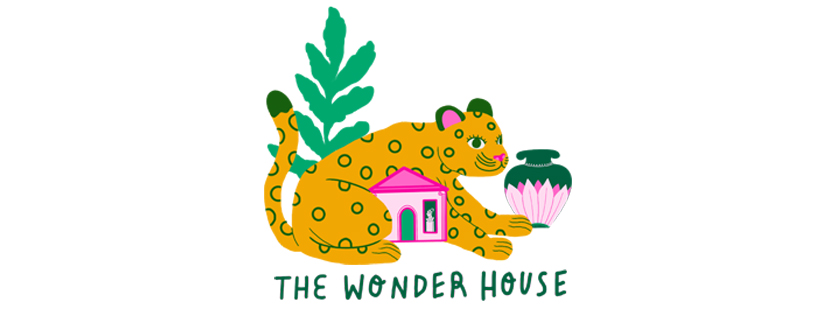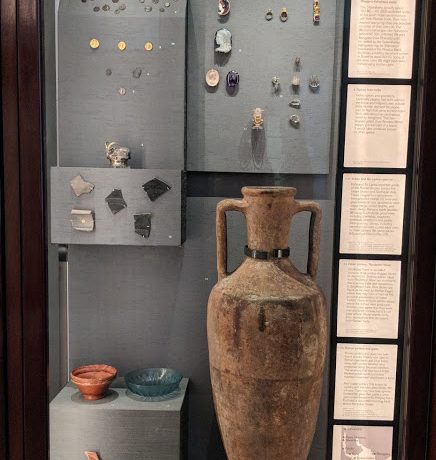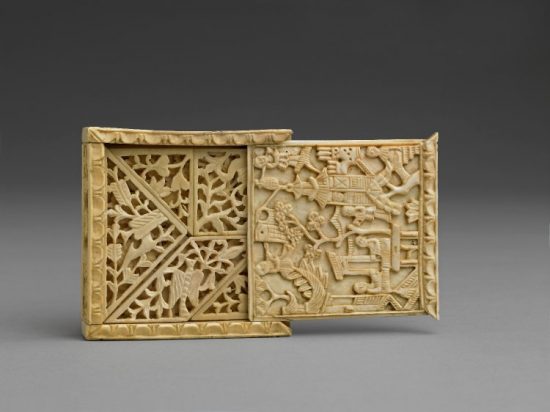One of the most important objects in the South Asia collections at the British Museum is also one of the most unassuming. It is a small sandstone fragment inscribed in Brahmi characters which once formed part of a monolithic pillar that was originally erected near Meerut, Uttar Pradesh in the mid-3rd century BC by the Mauryan Emperor Asoka. Over the next 2000 years, under the Delhi Sultanate, Mughal Empire and British colonial rule, this pillar was successively moved, blown up and restored. At some point during the eventful life of the pillar, a small fragment was moved to the India Museum in London and, after this museum closed in 1879, it was transferred to the British Museum where it is now on display in the refurbished Sir Joseph Hotung Gallery for China and South Asia.
I was fascinated by the multiple stories embodied in this small fragment and in this blogpost I explore the challenges of displaying it while also delving into its intriguing history.
Why is this fragment important?
Emperor Asoka (c.268-232 BC) was the third ruler of the Maurya dynasty which was founded by Chandragupta in c.321 BC when he overthrew the Nanda dynasty. The heartland of this empire was in Magadha, a region at the centre of the Ganges Plain, and its capital city, Pataliputra, lay on the banks of the River Ganges. The Mauryan empire reached its zenith during Asoka’s rule and fell less than 50 years after his death.
During his reign, Asoka had many inscriptions inscribed on pillars, rocks and cave walls across the subcontinent. They imparted a range of messages, such as: Asoka’s dharma and spreading this dharma, Buddhism and the Buddhist sangha, administration, animal welfare and his dedication of caves to a range of religious orders. These inscriptions were the first monumental texts of South Asia. Most of them, including the small fragment now at the museum, were written in Prakrit, a vernacular language, using Brahmi script, which is the ancestor of most modern scripts used in South Asia today. Those inscribed in the northwestern part of the subcontinent - present-day Afghanistan and Pakistan - were also written in Greek, Aramaic and Kharoshthi.
Many Asokan pillars were erected by important Buddhist sites such as Sarnath, where the Buddha preached the First Sermon, and surviving examples are found in the northern part of the subcontinent. Interestingly, representations of these pillars sometimes decorate later Buddhist stupa railings (Bharhut) and gateways (Sanchi). While most of the pillars are no longer in a complete state, they were originally topped with beautifully carved capitals in 3 constituent parts: a lotus base, abacus and an animal. Only 7 capitals survive: 5 lions (Sarnath, Sanchi, Vaisali, Rampurva, Lauriya Nandagarh), 1 elephant (Sankissa) and 1 zebu bull (Rampurva).
Most of the pillars known today are inscribed and they bear either Minor Pillar Edicts or Major Pillar Edicts I-VI or I-VII. The Minor Pillar Edicts deal with with a range of subjects such as Asoka’s visit to Lumbini, the Buddha’s birthplace; his instruction that his Queen should be credited with the gifts she endowed; and the so-called Schism Edict in which Asoka announces that schism should be prevented in the Buddhist sangha. In contrast, the Major Pillar Edicts focus on Asoka’s dharma and associated matters including, for example, duties of administrators (Rajukas), and a list of animals that cannot be killed and those which can be killed (and when). The fragment at the British Museum bears part of the text of Major Pillar Edict VI.
This small, inscribed fragment, then, is the starting point for wide-ranging discussions about the Mauryan period, including religion and language. The curatorial challenge was how to present something that doesn’t, at first glance, look particularly interesting - especially when compared with the eye-catching figurative sculpture and glittering jewellery which are also displayed in the same section. There is also another important research aspect: the history of the object itself. The speed at which the gallery project progressed meant that, until recently, I wasn’t able to delve into the fascinating collecting history which links it to Firuz Shah Tughluq, Timur, James Prinsep and Alexander Cunningham.
Here, I’ve put together my display notes for the Asokan pillar fragment (Reg. no. 1880.21) before writing about its collection history.

Display with Asokan inscription at the centre in the Early History section of the Hotung Gallery. Photo © Sushma Jansari
‘…for the welfare and happiness of the world’
At the entrance to each section of the gallery, there are large panels with the following information running from top to bottom: a quotation - in the original script and a translation into English - that is relevant to the period on display; a brief overview of the key messages for the bay; and at the bottom a map showing some important sites associated with the objects on display. The pillar fragment is displayed in the Early History section and for the panel at the entrance to this bay, I was keen to use the text from the Asokan pillar fragment on display, not least because the quotation, of which it was a small part, is a deeply moving one.
The fragment bears some words from the last two lines of Major Pillar Edict VI. After discussing translations with a colleague who was at that time at SOAS, and who also kindly helped with another translation in another section with one of his students, I settled on Romila Thapar’s translation: ‘…I had an inscription of Dharma engraved for the welfare and happiness of the world. Whoever follows it should obtain progress in Dharma in various ways.’ Stefan Baums, of the University of Munich, generously generated the Brahmi script so that it could be reproduced on the panel.
The pillar fragment sits in a section which includes diverse objects, ranging from sculpture to coins, reliquaries, jewellery and pottery, which date from the 4th century BC to the 2nd century AD. Given the 600 year timespan and wide-ranging stories covered in this section, the development of the narrative and placement of objects took on added importance because it could quite easily become disjointed and incoherent. It was the very first section of the very first gallery display I had ever worked on, so disjointed and incoherent was something I was hoping to avoid.
My first step was to place the fragment at the centre of the display making it a Gateway Object to this section. This position signifies that it is a key object in this section and worth taking a closer look at. Everything else took shape around this placement. To the immediate right, my colleague Daniela curated a section on early coinage from South Asia as well as archaeological finds such as pot sherds and terracotta figures. To the left and immediately in front of the pillar fragment I displayed reliquaries and a sculpture of a yaksi from Sanchi, an important Buddhist site where Asoka erected a pillar and may also have built a stupa. The nature and position of this material drew connections between Asoka, these sites and Buddhism, which were also touched on in the label text I wrote for them.
The next step was to provide some context for the fragment as a small component of a much larger edifice: specifically a pillar with an ornate capital. All of the Gateway panels in the Hotung Gallery have a contextualising image, whether of a type of site or structure, or an individual, associated with the object on display in some way. I could have included an image of the reconstructed Meerut-Delhi pillar which was re-erected on the Ridge outside Delhi, but instead selected the pillar from Lauriya Nandagarh, Bihar. This is because, unlike the Delhi-Meerut pillar, it is still standing in situ and has an intact capital with a lotus base, abacus and seated lion on top.
Linking the past with the present
Many images, motifs and objects from antiquity have contemporary resonance and this is something I have written about in my academic work and am also keen to draw attention to through my curatorial displays. The Asokan pillar fragment provided a good opportunity to make such a link.
After Indian Independence from British colonial rule, the government of India based the new state emblem on the Asokan lion capital from Sarnath. This symbol was first used on 26th January 1950 when India became a secular republic. It appears on all Indian currency, stamps, passports and official government publications. To emphasise this point, I displayed a selection of coins and banknotes from the collections in the Dept. of Coins and Medals, and stamps which I bought especially for the display, below the pillar fragment. All of this material dated from the period when the emblem was first used. On the label which accompanied these objects, I added a photograph of the four lion capital from Sarnath.
In 2013, I visited Sarnath with my family and saw the lion capital in person in the Sarnath museum. It was an extraordinary experience to walk among the ruins in the site and to see the exceptional collections in the museum. Unfortunately, it was not possible to take photos in the museum, otherwise I’d probably still be there clicking away. I did, however, take a lot (a LOT!) of photos of the site and included one of these in the display of the two 5th century AD Buddha figures from Sarnath in the Gupta section of the Hotung Gallery.
Collection history
There is a long history of rulers in India moving Asokan pillars. For example, the pillar originally erected by Asoka at Kausambi was moved by a number of rulers from the 13th century onwards and, finally, the Mughal Emperor Jahangir (r.1605-27) moved it to its current location in Allahabad, Uttar Pradesh. Through the ages, kings, pilgrims and others have also added their own inscriptions to different pillars. The one at Allahabad carries the original Asokan inscription as well a lengthy inscription from the Gupta ruler Samudragupta (r.c. AD 330-76), one by Akbar’s advisor Birbal (1528-86) and another from Jahangir.
Given the multiple histories that converge on these pillars, I was curious to learn more about the historical characters involved in the movement of the Delhi-Meerut pillar and, particularly, how a small fragment from this pillar came to be at the British Museum. My starting point was the information contained in the object record.
The journey of the Asokan pillar fragment from a place near Meerut, Uttar Pradesh, where it was originally erected, to the Indian Museum in Kolkata, and eventually to the British Museum, begins with Firuz Shah Tughluq (1309-88). At this point, my own learning journey begins because this period of history is outside my area of expertise. In 1351, Firuz Shah succeeded his cousin Muhammad bin Tughluq to the Delhi Sultanate and ruled until 1388. Information about Firuz Shah’s rule survives in various sources, including the Ta’rikh-i Firuz Shahi by the historian Shams-i-Siraj ‘Afif which survives in partial form in various manuscripts, and Firuz Shah’s autobiography Sirat-i Firuz Shahi. Both of these sources discuss his involvement with the movement and re-installation of the Asokan pillars.
During his reign, Firuz Shah moved three Asokan pillars. Only the shafts, not capitals, of these pillars appear to have survived from antiquity. Of the three pillars, only the one at Firuz Shah Kotla (Delhi-Topra pillar) remains in good condition, although in recent years it has been reported that the surface of this particular pillar has deteriorated and parts of the inscription have been lost. This is especially unfortunate because the Delhi-Topra pillar bears the only known example of Major Pillar Edict VII.

Illustration showing how the Asokan pillar was moved by Firuz Shah, from a copy of the Sirat-i-Firoz Shahi, 1593-94. Khuda Bakhsh Library, Patna published in Sunday Tribune.
The first pillar, the original location of which is unknown, was installed in the floor of the mosque inside the old palace complex constructed by Firuz Shah at Hisar, Haryana. Firuz Shah had this part of the pillar inscribed with his now famous history of the Tughluq dynasty (see: Shokoohy 1988). According to ‘Afif, when Timur stopped here, he ordered the horsemen in his army to gather firewood which he then placed around the base of the pillar and set alight, thereby badly damaging the pillar and destroying any earlier inscriptions.
Another section of what may be part of this original pillar sits on the floor within the mosque courtyard in Fatehabad, Haryana, northwest of Hisar. Firuz Shah founded Fatehabad and named it after his son Fateh Khan who appears to have moved part of the pillar in Hisar to this city after his father’s death (Falk 2006; Allen 2012). Falk notes that the Asokan inscription may have been on the middle part of the original pillar which no longer survives at either site because of damage to the pillar.
Firuz Shah moved a pillar from Topra to Firuzabad, a city he founded near Delhi and by the River Yamuna in 1354. Now known as Firuz Shah Kotla, he constructed a special tiered building upon which the Asokan pillar was erected and it still stands there today. In the Ta’rikh-i Firuz Shahi, ‘Afif writes a fascinating account explaining how the column was moved and hefted into place. He notes that it was carefully wrapped in reeds and skins before being dragged onto a specially constructed 42-wheel carriage and transported to the Yamuna, where Firuz Shah himself awaited with numerous large boats to carry it to Firuzabad. ‘Afif also tells us that he was 12 years old when the pillar was erected in the city and describes this process in some detail, suggesting that he was an eye-witness to this extraordinary undertaking.
The third and final pillar moved by Firuz Shah is linked with the fragment now at the British Museum. ‘Afif informs us that this pillar was found in Mirat (Meerut) and transported ‘with similar skill and labour‘ as the Topra pillar but this time to Firuz Shah’s Kushk-i Shikar or ‘hunting palace’. This building was located on the Delhi Ridge near Old Delhi and the reconstituted Asokan pillar can still be seen here, on the road leading to the Hindu Rao Hospital. This building was originally built by William Fraser (1784-1835), agent to the Governor General of Delhi. On his death, the house was purchased by Hindu Rao, brother-in-law of the Maharaja of Gwalior. It was badly damaged during the 1857 Rebellion.
Reconstituted, you ask? Yes. Unfortunately, it had an eventful life, but unlike the pillar at Hisar, this pillar was not damaged at the hands of Timur. Notably, Timur was impressed by the Delhi-Meerut and Delhi-Topra pillars: ‘Afif writes, ‘In these days, in the year 801 H [AD 1398], Amir Timur, of Khurasan, has marched into India, and by the will of fate has subdued the empire of Hindustan. During his stay of some days in Delhi, he inspected all the monuments of former kings, and among them these two obelisks [the Topra and Meerut pillars moved by Firuz Shah], when he declared that in all the countries he had traversed he had never seen any monuments comparable to them.’
After ‘Afif’s reference to the pillar in the mid-14th century, at least two further authors writing in the 17th century mentioned that it was still standing intact. Once of these authors was the English trader William Finch who lived and travelled in India for almost 4 years between 1608-11: ‘About 2 c. without Dely [Delhi] is the remainder of an auncient more or hunting house, built by Sultan Berusa [Firuz Shah], a great Indian monarch, with much curiositie of stonework. With and above the rest is to be a stone pillar, which, passing through three stories, is higher than all twenty foure foot, having at the top a globe and a halfe moone over it….‘. This information was contained in his journal which was subsequently published. By the time of Father Joseph Tieffenthaler’s visit in the mid-18th century, the pillar was lying broken by the large square pedestal at the top of the ridge. Tieffenthaler, a Jesuit missionary and geographer, explained that an explosion of powder blew it up into the air and it broke into several pieces, of which 5 were still extant when he visited the site.
The story picks up again in the 1830s when yet another power, this time the East India Company, had established rule across swathes of India. In an article in the Journal of the Asiatic Society of Bengal, James Prinsep (1799-1840), Assay Master of the Calcutta Mint and decipherer of the Asokan inscriptions, mentions that he received from one Major Pew both information about the ‘broken pillar lying in the late Mr. W. Fraser’s grounds’ and ‘impressions of the broken pillar’. I include part of this report here because people tend to focus on Cunningham’s work for this information, but he derived it from this earlier work. Part of Prinsep’s (1837: 795) quotation of Pew’s report:
‘This very ancient Hindu pillar was dug out of some ruins near a boulee (baoli) or well, and was probably destroyed by the blowing up of a powder magazine which I understand once existed near the spot. It consists of five pieces, which when put together measure 32 3/4 feet long: the diameter of the largest piece is 3 feet 2 inches, and that of the smallest 2 1/2 feet. The total weight 372 maunds.
The extreme antiquity of the pillar is vouched by its weather-worn aspect, which must needs be the effect of storms and rains that ran their destructive or beneficial course many centuries ago, since the fragments of this column have only been recently disinterred from the mass of ruin, evidently Hindu, where they had reposed in silence and darkness for ages.’

Portrait of Farrukhsiyar from Bibliothèque Nationale de France, Paris. Image from Wikimedia Commons.
Pew appears to have gathered information about the powder magazine and explosion locally, and these details have been accepted and linked with the destruction of the pillar ever since. Sir Alexander Cunningham, the first Director General of the Archaeological Survey of India (ASI), adds some detail to this report, writing (1871: 167), ‘According to popular belief, this pillar was thrown down by an accidental explosion of a powder magazine in the time of Farokhsir [the Mughal emperor Farrukhsiyar], who reigned from A. D. 1713 to 1719. This tradition is rendered almost certain by Padre Tieffenthaler, who resided in India between A. D. 1743 and 1786.’
Notably, when Prinsep was writing his article in c.1837, he was not working directly from the inscription itself from the Meerut-Delhi pillar; instead, Pew had sent impressions of the inscription on the pillar to him. However, at some point within the next 30 years, the pillar inscriptions were transferred to the Asiatic Society Museum in Calcutta. Cunningham (1871: 167) tells us that while the pillar fragments still lay on the Ridge where they fell during the explosion some 150 years earlier, ‘the upper end of the middle piece, which was inscribed with Asoka’s edicts, was sawn off some years ago, and sent to Calcutta, where it may now be seen in the Asiatic Society’s Museum.’ He then adds in a footnote, ‘This has now been returned to Delhi, and the pillar has been restored‘. The addition of this footnote suggests that the return of the inscription to Delhi and subsequent restoration of the pillar occurred while he was writing this book, which was published in 1871. The year 1867 given by Fuhrer (1891: 11) for this restoration, therefore, seems reasonable.
Interestingly, petitions appear to have been made to the Government for money and resources to re-erect Asokan pillars since at least the 1830s. Vide Prinsep’s article (1837: 576) in which he notes ‘the inability of the present Government to afford the expense even of setting the Allahabad pillar upright on its pedestal…‘. Why the Delhi pillar was selected for restoration in this period is unclear.
The inscription from the Delhi-Meerut pillar must have been divided into more than one portion because while the major part of the inscription can still be seen cemented into the middle panel of the pillar on the Ridge, Falk (2006: 182) notes that the upper part of the edicts subsequently went missing with the single exception of one small fragment (H 12.2 x W 32.6 x D 7.6 cm). This particular fragment was sent to the India Museum in Leadenhall Street, presumably before 1867 when the pillar in Delhi was re-erected. When the India Museum closed in 1879, its collections were transferred to the South Kensington Museum (‘V&A’). In 1880, some of these collections were dispersed to the British Museum, and it was at this point that the Meerut-Delhi pillar fragment was sent to Bloomsbury.
It is not clear when, or under whose orders, the inscription was sent to Calcutta in the first instance. Cunningham (1875:143) simply writes, ‘After lying on the ground for nearly one hundred and fifty years, it has again been set up by the British Government on the same ridge where it was placed by Firoz Shah.’ It is tempting to suggest that Major Pew sent the inscription to Prinsep after 1837, but Prinsep became gravely ill in 1838, travelled to England to recuperate and died soon after in 1840.
Cunningham is another possibility. He was long involved with archaeological sites and known for his interest in and work on the Asokan inscriptions. He notes, for example, that he personally visited all of the pillars and took ‘fresh impressions’ of them while his draftsman Babu Jamna Shankar Bhat worked on them for the ensuing publication’ (1877: i). So it is possible that he sent the inscriptions to Calcutta and may have had some involvement in the restoration. These suggestions, however, must remain speculative.
It is fascinating to think of the many people who looked upon the various Asokan pillars and played a role in their later lives. Sometimes, like Samudragupta, Firuz Shah, Jahangir and others, they inscribed their names and histories alongside the Asokan inscriptions, leaving us valuable historical texts. Others, like Timur, wrought destruction on some and yet left others untouched. Later still, British colonial officials were also intrigued by these pillars and Prinsep deciphered and translated the inscriptions for a new audience. During the millennia the pillars have been standing, they were also interpreted in different ways by the people who encountered them. But that is a story for another time.
Select Bibliography
Sirat-i-Firuz Shahi is held at the Khuda Bakhsh library, Patna, and has been digitised - http://kblibrary.bih.nic.in/Digitization/Sirat%20I%20Firuz%20Shahi.pdf
C. Allen, Ashoka: The Search for India’s Lost Emperor (London: Hachett, 2012)
A. Cunningham, Corpus Inscriptionum Indicarum. Vol. I. Inscriptions of Asoka (Calcutta: Office of the superintendent of government printing, 1877)
H. Falk, Asokan Sites and Artefacts: A Source-book with Bibliography (Mainz: Philipp von Zabern, 2006)
P. Jackson, The Delhi Sultanate: A Political and Military History (Cambridge: CUP, 2003)
H.P. Ray, The Return of the Buddha: Ancient Symbols for a New Nation (New Delhi: Routledge, 2014)
M. Shokoohy, Corpus Inscriptionum Iranicarum, Part IV. Persian inscriptions down to the early Safavid period, vol. XLVII, India. State of Haryana. Haryana I: the column of Firuz Shah and other Islamic inscriptions from the district of Hisar (London: SOAS, 1988)
N. H. Zaidi, “ʿAFĪF,” Encyclopaedia Iranica, Online Edition, 1982
















No Comments